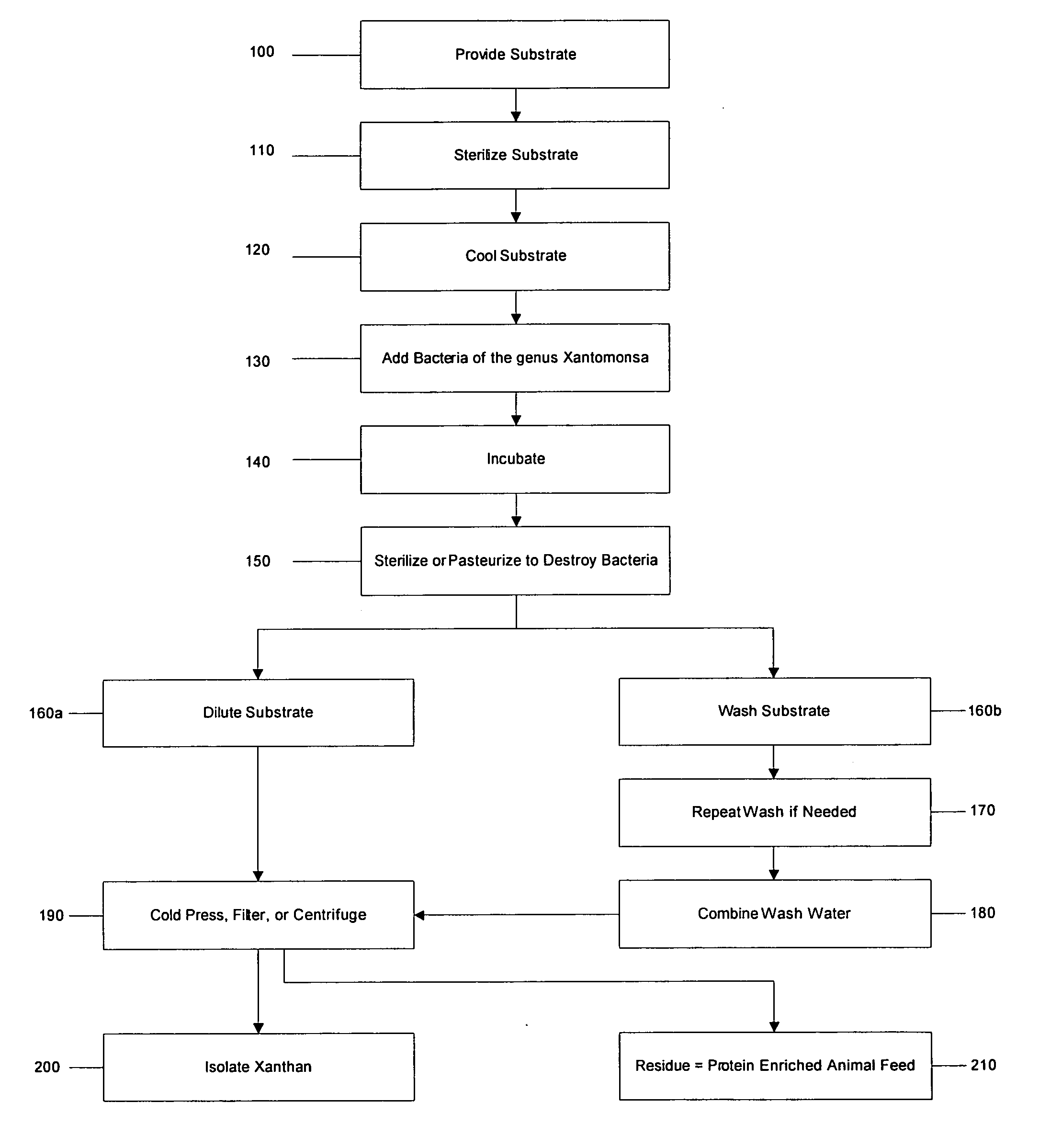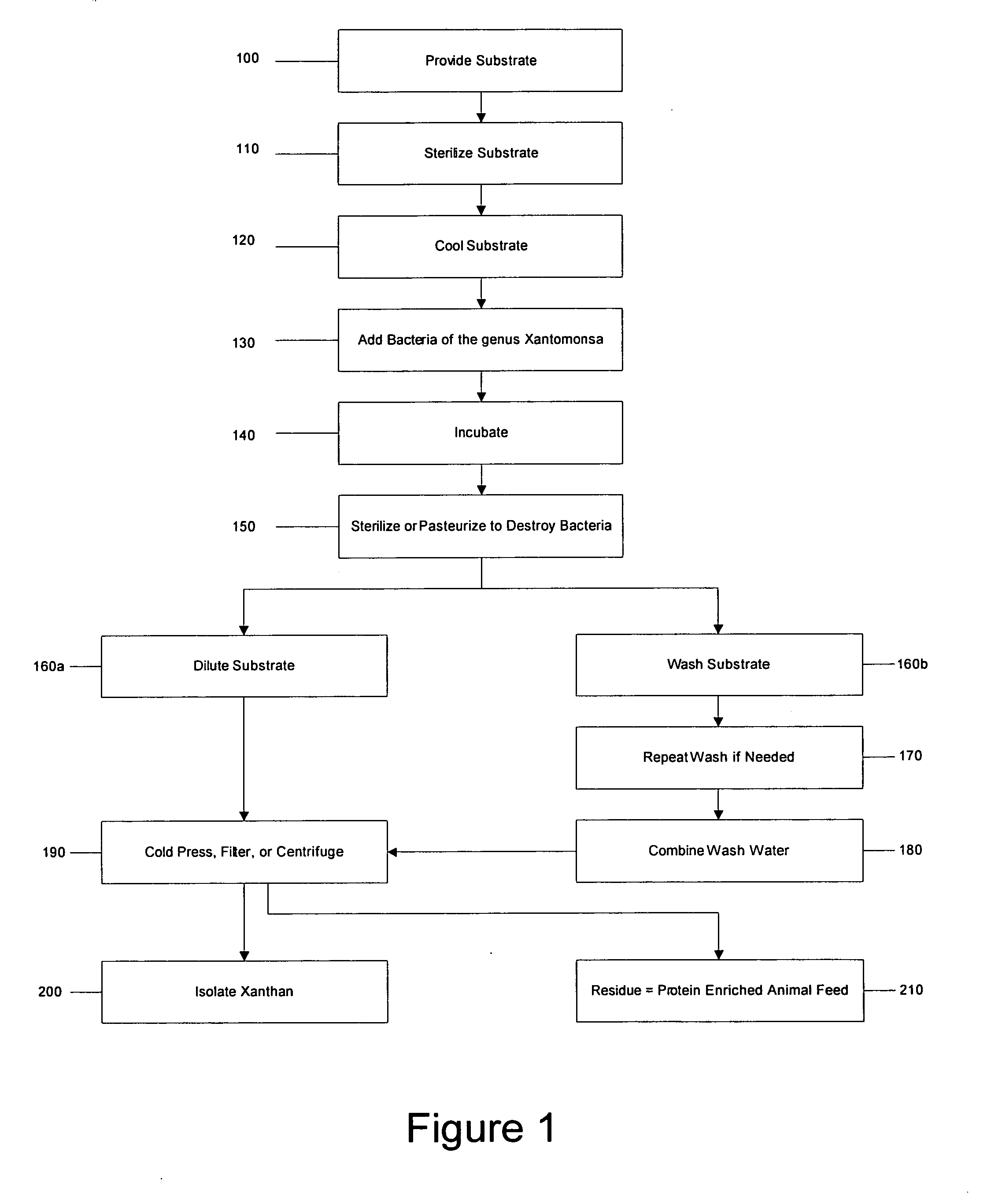Solid or semi-solid state fermentation of xanthan on potato or potato waste
a technology of xanthan gum and potato waste, which is applied in the direction of fermentation, etc., can solve the problems of large amount of solvents, reducing both the yield and quality of xanthan
- Summary
- Abstract
- Description
- Claims
- Application Information
AI Technical Summary
Benefits of technology
Problems solved by technology
Method used
Image
Examples
example 1
[0027]50 mL of standard glucose substrate of the composition listed in Table 1 and 50 grams of potato waste substrate of the composition listed in Table 1 were added into 500 mL Erlenmeyer flasks and sterilized for 15 minutes at 121° C. After cooling, 5.0 ml of Xanthomonas campestris NRRL B-1459 suspension, which had been grown on standard medium for 3 days, was added as inoculum. The flasks were incubated on the rotary-shaker at 28° C. and 250 RPM for 4 days. After dilution with de-ionized, distilled water (ddH2O) and sterilization, raw xanthan was isolated after the addition of KCl to 1% and precipitation with 98% C2H5OH to make the final C2H5OH concentration >71%. The results in Table 1 show that more xanthan was produced in the solid state fermentation with a potato waste medium than was produced in the submerged fermentation with a standard glucose medium, where both fermentations were incubated at 250 RPM.
TABLE 1ItemAmount or RemarkMediumStandard GlucosePotato WasteGlucose1.00...
example 2
[0028]By the procedures of Example 1, the set of experiments was repeated with a semi-solid state fermentation of the potato waste medium as indicated in Table 2. As shown in Table 2, the semi-solid state fermentation with a potato waste medium produced more xanthan than the submerged fermentation with a standard glucose medium, where both fermentations were incubated at 250 RPM.
TABLE 2ItemAmount or RemarkMediumStandard GlucosePotato WasteGlucose1.00 g0.0 gPotato Waste0.0 g50.40 gYeast extract0.25 g0.0 gK2HPO4*3H2O0.25 g0.25 gMgSO4*7H2O0.01 g0.0 gH2O50.0 mL25.0 mLFermentation ModeSubmergedSemi-solidIncubated at250 RPM250 RPMXanthan after 4 days0.388 ± 0.010 g0.492 ± 0.007 g
example 3
[0029]By the procedures of Example 1, the set of experiments was repeated using Xanthomonas campestris NRRL B-1003 with changes indicated below and in Table 3.
[0030]50 grams of potato waste substrate of the following composition were added into 1,000 mL rolling bottles and sterilized for 15 minutes at 121° C. After cooling, 5.0 ml of Xanthomonas campestris NRRL B-1003 suspension, which had been grown on standard medium for 3 days, was added as inoculum. The bottles containing the potato substrate were incubated on the rolling apparatus at 28° C. and 5.0 RPM for 4 days. After dilution with ddH2O and sterilization, raw xanthan was isolated after the addition of KCl to 1% and precipitation with 98% C2H5OH to make the final C2H5OH concentration >71%. The results in Table 3 show that more xanthan was produced in the solid state fermentation than was produced in the submerged fermentation when both fermentations were incubated at 5.0 RPM.
TABLE 3ItemAmount or RemarkMediumStandard GlucosePo...
PUM
| Property | Measurement | Unit |
|---|---|---|
| molecular weight | aaaaa | aaaaa |
| temperature | aaaaa | aaaaa |
| temperature | aaaaa | aaaaa |
Abstract
Description
Claims
Application Information
 Login to View More
Login to View More - R&D
- Intellectual Property
- Life Sciences
- Materials
- Tech Scout
- Unparalleled Data Quality
- Higher Quality Content
- 60% Fewer Hallucinations
Browse by: Latest US Patents, China's latest patents, Technical Efficacy Thesaurus, Application Domain, Technology Topic, Popular Technical Reports.
© 2025 PatSnap. All rights reserved.Legal|Privacy policy|Modern Slavery Act Transparency Statement|Sitemap|About US| Contact US: help@patsnap.com


